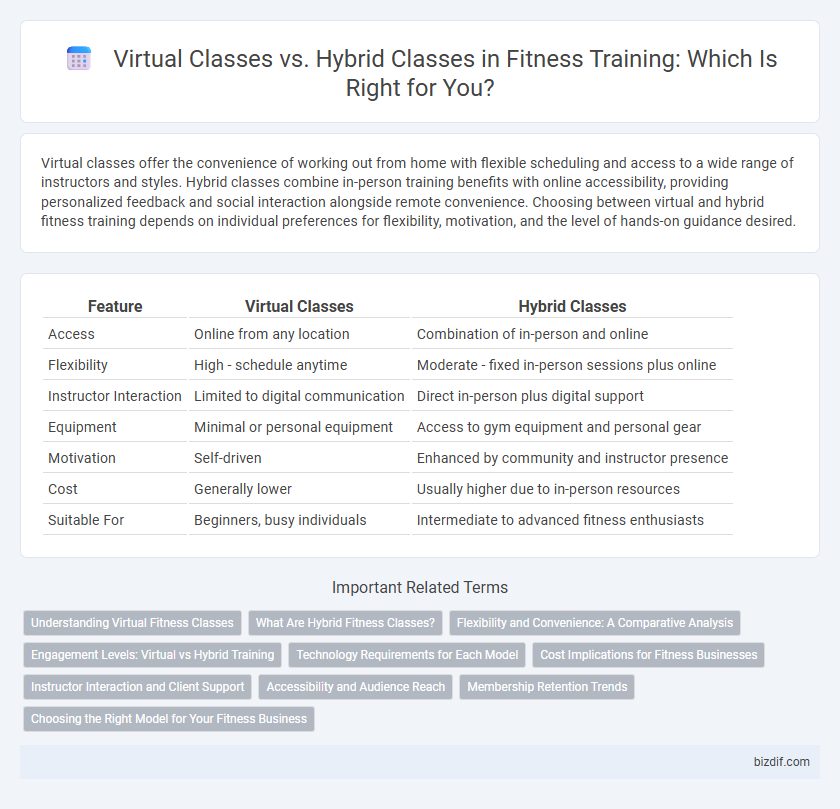Virtual classes offer the convenience of working out from home with flexible scheduling and access to a wide range of instructors and styles. Hybrid classes combine in-person training benefits with online accessibility, providing personalized feedback and social interaction alongside remote convenience. Choosing between virtual and hybrid fitness training depends on individual preferences for flexibility, motivation, and the level of hands-on guidance desired.
Table of Comparison
| Feature | Virtual Classes | Hybrid Classes |
|---|---|---|
| Access | Online from any location | Combination of in-person and online |
| Flexibility | High - schedule anytime | Moderate - fixed in-person sessions plus online |
| Instructor Interaction | Limited to digital communication | Direct in-person plus digital support |
| Equipment | Minimal or personal equipment | Access to gym equipment and personal gear |
| Motivation | Self-driven | Enhanced by community and instructor presence |
| Cost | Generally lower | Usually higher due to in-person resources |
| Suitable For | Beginners, busy individuals | Intermediate to advanced fitness enthusiasts |
Understanding Virtual Fitness Classes
Virtual fitness classes offer flexible, instructor-led workouts accessible from any location with internet connectivity, leveraging live streaming or on-demand content to cater to diverse fitness levels. These classes utilize digital platforms such as Zoom, Peloton, or Mirror to foster community interaction and real-time feedback despite physical distance. The emphasis on convenience and adaptability makes virtual training a popular choice for individuals seeking personalized guidance without commuting to a gym.
What Are Hybrid Fitness Classes?
Hybrid fitness classes combine virtual and in-person training sessions, offering flexibility and personalized coaching to accommodate varying schedules and fitness levels. They integrate live-streamed workouts with on-demand videos, enabling participants to engage from home or attend physical classes when preferred. This blended approach enhances motivation and accountability by delivering real-time instructor feedback alongside convenient at-home options.
Flexibility and Convenience: A Comparative Analysis
Virtual classes offer unparalleled flexibility and convenience by allowing participants to join workouts anytime and anywhere, eliminating commute time and fitting easily into varied schedules. Hybrid classes blend in-person interaction with remote access, providing both the structured environment of a gym and the adaptability of online sessions, catering to diverse preferences and lifestyle demands. This combination enhances user engagement by accommodating fluctuating availability while maintaining professional guidance and community connection.
Engagement Levels: Virtual vs Hybrid Training
Virtual fitness classes offer convenience and accessibility, yet they often struggle to sustain high engagement levels due to limited real-time interaction and lack of physical presence. Hybrid classes combine online and in-person elements, enhancing participant motivation and accountability through direct social interaction and personalized feedback. Studies indicate hybrid training results in improved adherence and higher energy levels, fostering a more immersive workout experience.
Technology Requirements for Each Model
Virtual fitness classes require a reliable high-speed internet connection, a compatible device such as a smartphone, tablet, or computer, and a fitness app or video conferencing platform like Zoom or Peloton to stream workouts seamlessly. Hybrid classes combine in-person training facilities with digital platforms, necessitating both physical gym equipment and technology infrastructure, including Wi-Fi, audio-visual systems, and scheduling software to accommodate simultaneous virtual and physical attendance. Investing in quality cameras, microphones, and user-friendly interfaces enhances the experience for participants and trainers in both models, ensuring engagement and effective communication during sessions.
Cost Implications for Fitness Businesses
Virtual fitness classes significantly reduce overhead costs for fitness businesses by eliminating the need for physical space, equipment maintenance, and on-site staff, allowing for scalable operations with minimal expenses. Hybrid classes, combining in-person and virtual elements, incur higher costs due to facility maintenance and staffing but enable broader customer engagement and premium pricing strategies. Both models offer unique cost implications, with virtual classes optimizing budget efficiency and hybrid classes balancing expenses with enhanced service delivery.
Instructor Interaction and Client Support
Virtual fitness classes offer consistent instructor interaction through live video sessions, enabling real-time feedback and motivation. Hybrid classes combine in-person training with virtual resources, providing personalized support that adapts to individual client needs and schedules. Client support in hybrid models often includes direct hands-on corrections and tailored progress tracking, enhancing engagement and results.
Accessibility and Audience Reach
Virtual classes in fitness training offer unparalleled accessibility, enabling participants to join sessions from any location with an internet connection, significantly broadening audience reach. Hybrid classes combine the benefits of in-person interaction with online convenience, appealing to a diverse demographic by accommodating varying schedules and preferences. Both formats enhance accessibility, but hybrid classes often attract a wider audience by providing flexible participation options that meet both digital and physical engagement needs.
Membership Retention Trends
Virtual classes offer members flexibility and convenience, leading to higher initial engagement rates, but may face challenges in maintaining long-term retention due to limited personal interaction. Hybrid classes combine the benefits of in-person coaching with online accessibility, resulting in improved member loyalty and a 25% higher retention rate compared to purely virtual options. Fitness centers adopting hybrid models report increased satisfaction and sustained membership growth by catering to diverse preferences in workout delivery.
Choosing the Right Model for Your Fitness Business
Virtual classes offer flexibility and accessibility by allowing clients to join workouts from anywhere, making them ideal for expanding reach and accommodating busy schedules. Hybrid classes combine in-person interaction with online convenience, enhancing engagement and fostering community while providing diverse training options. Selecting the right model depends on your target audience preferences, technological capabilities, and business goals for growth and client retention.
Virtual Classes vs Hybrid Classes Infographic

 bizdif.com
bizdif.com